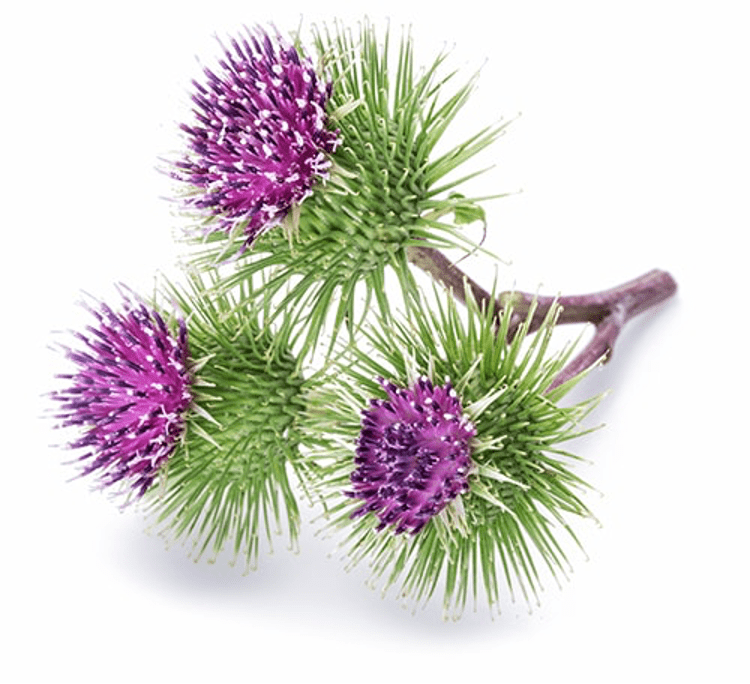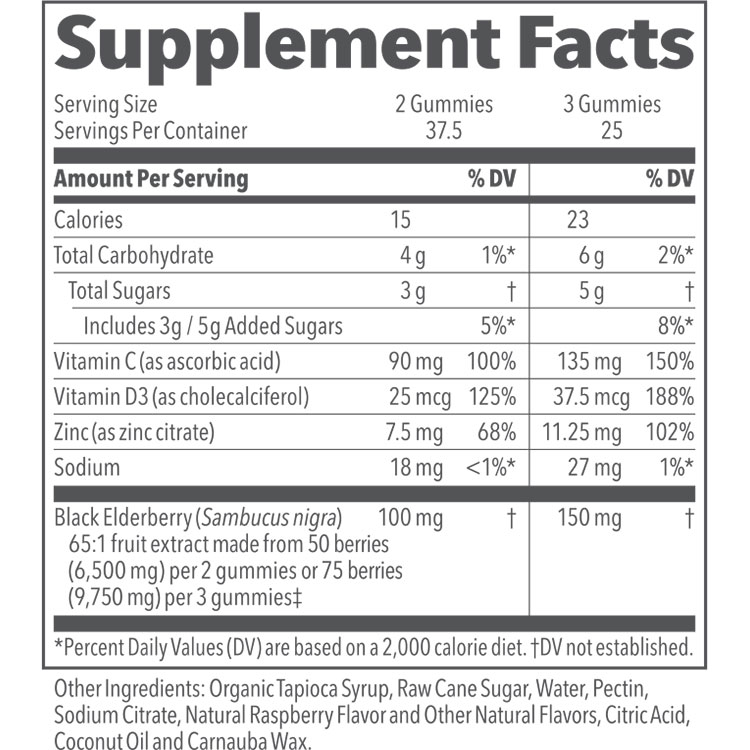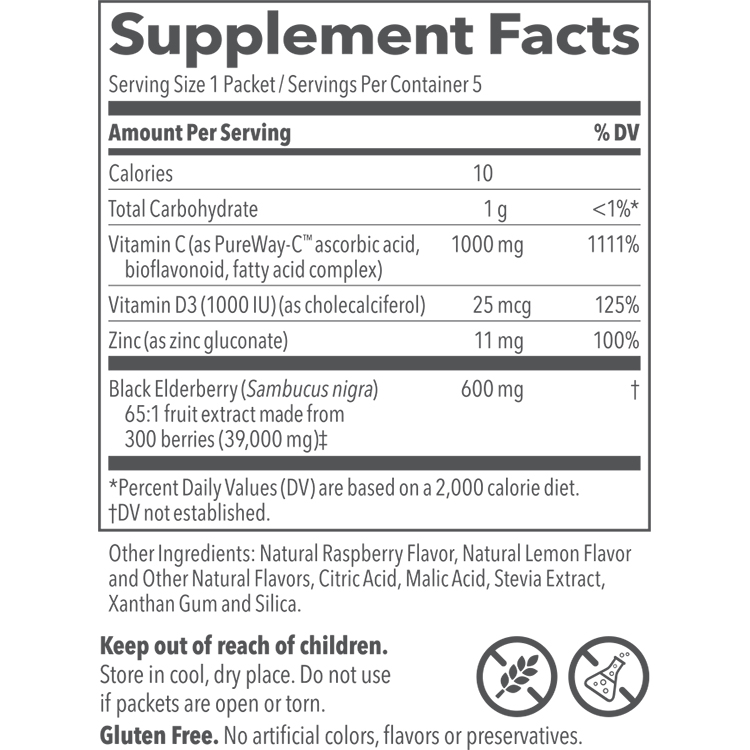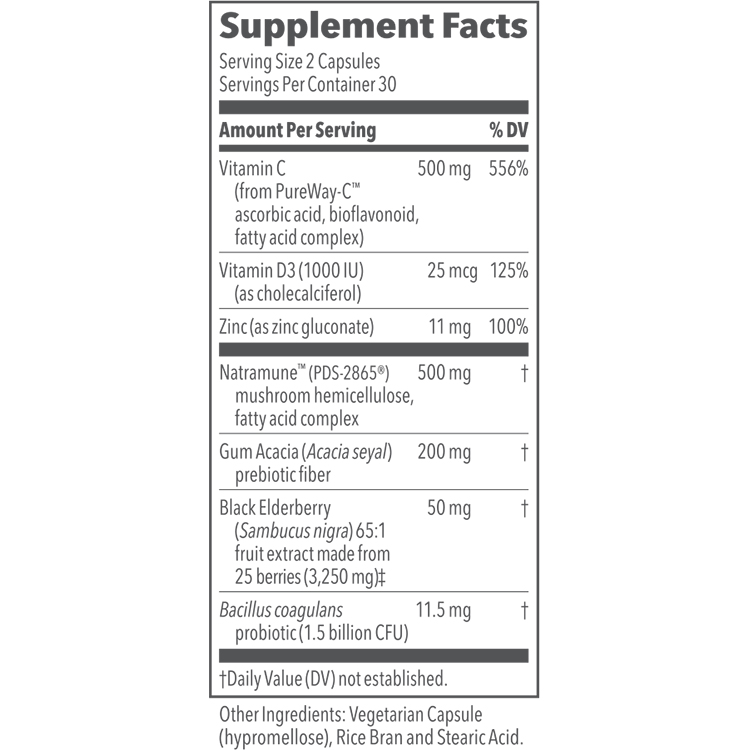BACKGROUND
Ingredient Type: Botanical
Also Known As: European burdock, Great burdock, Greater burdock, Woodland burdock, Arctium lappa

The burdock plant is a biennial plant that is native to Britain, China, Europe, and parts of North America. It is commonly identified by the plant’s flowers, which are globe-shaped clusters surrounding the top of the stem with protruding “hooks.” Burdock is a member of the sunflower family and is known for its versatility. Its bitter qualities promote more balanced appetitive and healthier digestion. It is also known to support the skin, liver function, and detoxification due to its ability to flush and cleanse the lymph and blood (2).
Mother went rambling, and came back with a burdock on her shawl, so we know that the snow has perished from the earth. – Emily Dickinson, Letters of Emily Dickinson (3).
In 1941, George de Mestral, a Swiss engineer, was hunting in rural Switzerland when he noticed small burrs sticking to his pant leg as well as his dog’s fur. This burr was later identified as the Burdock plant. After taking the burrs home and further analyzing them under a microscope, he was inspired to incorporate the hook-like mechanism common to the burdock plant to a clothing application. In 1948 De Mestral patented his idea and subsequently duplicated a “hook and loop” fastener that was inspired by the burdock plant. The result of his invention was the birthing of Velcro© fasteners, which is now a common household name (1).
TRADITIONAL USES
In folk medicine, burdock was used as a blood purifier, a diaphoretic, and a diuretic due to its pharmacological activity as a detoxifier. The root of the plant has qualities that aid in bile stimulation, liver cell regeneration as well as in supporting healthy uric acid levels. The herb is also said to act as an aphrodisiac. In the realms of Traditional Chinese Medicine, the seeds are used to expel wind-heat that accompanies fever, cough, sore throat, arthritis, rheumatism, anorexia nervosa, and various gastrointestinal disorders due to its inulin content. The phytosterols in the plant are used to stimulate natural hair growth. The root oil has been sold in Europe as a natural remedy for hair and scalp conditions due to the presence of these phytosterols (2,4).
WHAT DOES SCIENCE TELL US?
Burdock Possibly Supports Healthy Cell Growth:
In this study, the researchers investigated the maximum tolerated dose of GBS-01, which was an extract isolated from the A. lappa fruit, based on the frequency of the dose-limiting toxicities and pharmacokinetics in patients with advanced pancreatic cancer refractory to gemcitabine. Fifteen patients received either a level 1 dose (3.0 g), a level 2 dose (7.5 g), or a level 3 dose (12.0 g). Of the patients tested, there were no dose-limiting toxicities noted. There were, however, noted marker increases of serum y-glutamyl transpeptidase, hyperglycemia, and total serum bilirubin. Of the 15 patients, one patient showed a confirmed partial response to the GBS-01, while four other patients noted a stable disease state. From the results, it was concluded that there were favorable clinical responses at a dose of 12.0 g four times a day for patients with advanced pancreatic cancer refractory to gemcitabine (8).
In another study, a combination of arctigenin and quercetin (also found in A. lappa) were studied to determine if lower concentrations provide for an increase in anti-carcinogenic activity when used against prostate cancer. Androgen-dependent LAPC-4 and LNCaP prostate cancer cells were treated with low doses of arctigenin and quercetin for a period of 48-hours. It was noted that from the results, there was significant anti-proliferative activity from the arctigenin vs. the quercetin in both tested cell lines. Their combination, however, synergistically enhanced the anti-proliferative effect with a stronger effect on the androgen receptor wild-type LAPC-4 cells vs. the mutated LNCaP cells. From the study, it was found that the combination treatment significantly inhibited both AR and PI3K/Akt pathways in LAPC-4 cells while also inhibiting several oncogenic microRNAs compared to the control. It was found that a combination of both arctigenin and quercetin at low doses may provide a novel regimen in the prevention of prostate cancer (9).
A review was conducted concerning the different types of plants that retain immune-stimulating and anti-tumor properties. These phytochemicals have different mechanisms of action that can either stimulate protective enzymes or directly prevent cell proliferation. This review has focused on the biochemical properties of Allium sativum, Echinacea, Curcuma longa, Arctium lappa, Camellia sinensis, Panax ginseng, and flax seeds. According to the review, the volatile oils and extracts of these herbs and plants were noted to inhibit the synthesis of mevalonate, which help lessen tumor growth and cholesterol synthesis. Additionally, it was noted that the extracts and juices of Withania somnifera, Amoora rohituka, Dysoxylum binectariferum, and Vaccinium macrocarpon were seen as useful for ant-breast cancer alternatives (10).
A recent study investigated that in vitro anti-tumor activity of ten species of plants commonly grown in Southern Iran. An MTT colorimetric assay was used to evaluate the cytotoxic activities of the methanol extracts of the chosen plants used in this study on the tumor cell lines. The following results were noted from the study: Satureja bachtiarica, Satureja hortensis, Thymus vulgaris, Thymus daenensis, and Metha lonigfolia each showed inhibitory effects on Jurka cells with Satureja hortensis being the most effective. Cichorium intybus, Rheum ribes, Alhagi pseudalhagi, and Glycyrrihza glabra also showed notable efficacy against leukemia cell lines. It was concluded that the tumor cell lines most sensitive to the extracts responded best with Satureja bachtiarica, Thymus vulgaris, Thymus daenensis, and Metha lonigfolia as far as their inhibitory effect potential (11).
Burdock Might Support Healthy Skin:
The Arctium lappa fruit was used to determine the active ingredient which was proposed to improve the clinical signs of skin in vivo. Pure Arctiin was used when performing this investigational study to investigate the inhibition of cytokine induction while stimulating the collagen neo-synthesis. Studies using an A. lappa fruit extract-containing formulation were carried out to assess the following: procollagen and hyaluronan synthesis, hyaluronan synthase-2 gene expression, and wrinkle volume reduction post-treatment. The cells studied were human dermal fibroblasts and monocyte-derived dendritic cells supplemented with pure Arctiin. The results yielded that the respective cells vs. the control cells had stimulation of collagen synthesis and a decrease in interleukin-6 and tumor necrosis factor-alpha concentration. Additionally, the topical in vivo application of A. lappa over 12 weeks showed significant procollagen synthesis and increased hyaluronan synthase-2 expression along with a reduction in wrinkle volume in the crow’s feet area post-4-week treatment. From the results, it was concluded that an A. lappa extract could be an alternative treatment option for mature skin (7).
A randomized, double-blind, placebo-controlled study was conducted to determine the efficacy and safety of a proposed herbal moisturizing cream containing A. lappa seed extract. In the study, 66 health male and female adults (20 to 65 years old) who were previously clinically diagnosed with a skin condition, participated in this study for four weeks. The two groups were randomly assigned where one group received the proposed herbal moisturizing cream while the other group received the placebo cream. Each participant was examined pre and post-treatment for: skin hydration, sebum levels, and trans-epidermal water loss. Unfortunately, this study has still yet to be completed. However, it is hypothesized that the moisturizing cream would help treat various inflammatory skin ailments while still providing moisturization and protection for dry and sensitive skin (6).
Another study was conducted to determine the effectiveness of A. lappa in the treatment of acne vulgaris. This uncontrolled, observational study was conducted on 34 human participants. The A. lappa was prescribed in homeopathic potencies starting from 6c up to 1M for 6-months. The objective assessment has noted a change in the acne lesion size and counts along with a subjective assessment using an Acne-Specific Quality of Life Questionnaire (Acne-QoL). From the results, there was a significant change in lesion count reduction. It was concluded from this study that A. lappa has the potential to treat acne, especially the inflammatory type effectively. Further controlled studies of larger sample sizes are, however, necessary to support the A. lappa efficacy (5).
The purpose of a recent pilot study was to assess the effectiveness of burdock leaf therapy and B&W ointment on the pain associated with dressing changes, the presence of infection, and healing times of Amish burn victims in Ohio. The B&W ointment contained honey, lanolin, olive oil, wheat germ oil, marshmallow root, Aloe Vera gel, wormwood, comfrey root, white oak bark, lobelia inflata, vegetable glycerin, beeswax, and myrrh. In the study, nurses monitored each patient’s case along with associated documentation. This study was conducted between October of 2011 and 2013, where 5 Amish patients enrolled. All of the participants had either 1st or 2nd-degree burns. It was noted that minimal to no pain was experienced, no infections occurred, and healing times were less than 14-days on average with the use of the B&W ointment/ burdock leaf therapy. It was concluded that the use of this herbal remedy appears to be an acceptable alternative to conventional burn care for 1st and 2nd-degree burns (12). It was, however, recommended that any sort of burn care should be monitored by a medical professional, especially when using a natural alternative with little to known backed clinical research.
Burdock Possibly Supports a Healthy Liver:
A study was conducted to investigate the hepatoprotective potential of the Arctium lappa root on male ICR mice injected with carbon tetrachloride (32microl/kg) or acetaminophen (600 mg/kg). In this experiment, it was noted that the A. lappa suppressed SGOT and SGPT elevations initially induced by the administration of carbon tetrachloride CCI4 or acetaminophen in a dose-dependent manner; alleviating the severity of liver damage. From a mechanistic standpoint, the A. lappa was found to have reversed the decrease in glutathione and cytochrome P-450 induced by the CCI4 and acetaminophen. From this study, it was concluded that A. lappa has the potential to protect hepatic cells from damage associated with CCI4 or acetaminophen (18).
Another study conducted to evaluate the hepatoprotective effects on rats with hepatic damage induced by chronic ethanol consumption (4 g of absolute ethanol/80 ml) or carbon tetrachloride (CCI4) in a test group of 10 rats for 28 days. Control group rats were given a liquid basal diet, which was void of ethanol. At the time of the administration of the b A. lappa, it was noted that there were significant histopathological parameter adjustments in both groups receiving either the CCI4 and the ethanol. From the results, it was noted that A. lappa increased serum triglyceride levels and lipid peroxidation along with an elevation of serum transaminase levels. The A. lappa could even restore the glutathione content and affect histopathological lesions previously induced by the administration of the CCI4 or ethanol. From this study, it was concluded that A. lappa has the potential to alleviate hepatotoxic damage within 1–7 days of treatment in part due to its antioxidative activity (17).
A study was performed to determine the hepatoprotective effects of A. lappa against cadmium damage in the rat liver. In this study, male rats received a single dose of CdCl2with or without and extract of A. lappa, administered daily (300 mg/kg) for 7- or 56-days post cadmium administration. Following the 7-day treatment with A. lappa, subjects were noted to have diminished plasma transaminase activity (glutamic oxaloacetic transaminase (GOT), glutamic pyruvic transaminase (GPT) and CdAl (GPT). Following the 56-day treatment, GOT and GTP plasma activities were also reduced in the Cd-group. There were, however, no alterations in plasma levels of creatine, total bilirubin, and total protein. The GOT liver activity was also increased in the Cd group. Additionally, noted in the Cd-group was hepatocyte proportion decreased while sinusoid capillary proportion increased. These parameters conversely increased in the Al and CdAl groups. It was concluded that A. lappa has a hepatoprotective effect on those with hepatic induced cadmium damage (16).
Burdock Possibly has Antimicrobial Properties:
The antibacterial activity of a phytotherapeutic agent prepared from an ethyl acetate fraction (AcOEt) extracted from A. lappa compared with calcium hydroxide as an intracanal dressing. Twenty-seven maxillary canines were instrumented, sterilized and inoculated with a mixed bacterial suspension of Pseudomonas aeruginosa, Escherichia coli, Lactobacillus acidophilus, Streptococcus mutans, and Candida albicans. The canine teeth were divided into 3-respective test-groups: Group 1 – Calcium hydroxide and propylene glycol, Group 2 – A paste containing AcOEt fraction of A. lappa and propylene glycol and Group 3 – propylene glycol (control group). On days 7, 14, & 30, samples from the root canals of the canines were obtained, grown, and classified. The following results were noted: Group 1 had mild growth at all intervals, while Group 2 had severe growth on day seven but no growth on days 14 and 30. From this study, it was concluded that the phytotherapeutic agent extracted from the AcOEt fraction of A. lappa was able to inhibit the growth of all the noted organisms (15).
Another study was conducted to assess the antimicrobial activity of an A. lappa extracton Staphylococcus aureus, S. epidermidis, Streptococcus mutans, Candida albicans, C. tropicallis, and C. glabrata. In this study, the cytotoxicity was analyzed on macrophages. A broth microdilution method was used with different concentrations of the extract (250-0.4 mg/mL) to determine the minimum microbicidal concentration (MMC) in planktonic cultures. The results noted that the most effective concentration was 250mg/mL, which promoted a significant reduction in the biofilms of S. aureus, S. epidermidis, S. mutans, and C. albicans. The cell viability was at about 100% following the treatment with the A. lappa extract. From the results, the conclusion was that the A. lappa extract was microbicidal for all evaluated strains tested in planktonic cultures, micro biostatic for biofilms, and not cytotoxic to the macrophages (14).
A different study evaluated the in vitro antimicrobial activity of rough extracts from leaves of A. lappa and their respective phases. The following microorganisms tested, which are commonly found in the oral cavity, were: Enterococcus faecalis, Staphylococcus aureus, Pseudomonas aeruginosa, Bacillus subtilis, and Candida albicans. From the study, their assessment with bioautographic assays did analyze antimicrobial substances in the A. lappa extract. The suggested noted active constituents that exhibited specificity against the tested target microorganisms. From the study, it was gathered that the A. lappa extract constituents exhibited great microbial inhibition potential against the tested endodontic pathogens (13).
Burdock Possibly Decreases Inflammation:
In Chinese Herbal Medicine, A. lappa is commonly used to treat tissue inflammation. This study was conducted to investigate the effects of arctigenin (AC), which was isolated from A. lappa on anti-CD3/CD28 Ab-stimulated cell proliferation and cytokine gene expression in primary human T-lymphocytes. In this study, it was noted that the AC was able to inhibit primary human T-lymphocyte proliferation, which was previously activated by anti-CD3/CD28 Ab. The AB was also noted to have suppressed interleukin-2 (IL-2) and interferon-y production in a concentration-dependent manner. The reporter gene revealed that the AC decreased NF-AT mediated reporter gene expression, hence the cessation of inflammatory response. It was concluded that AC successfully inhibited T-lymphocyte proliferation while significantly decreasing gene expression of IL-2, IFN-y, and NF-AT (19).
Another study was conducted to determine whether or not a butanol extract of A. lappa (ALBE) had previously unreported anti-allergic or anti-inflammatory effects. The study examined the effect of ALBE on the release of B-hexosaminidase antigen-stimulated RBL-2H3 cells. The researchers also evaluated the ConA-induced expression of IL-4, IL-5, mitogen-activated protein kinases (MAPKs), and nuclear factor (NF-kB) in mouse splenocytes post ALBE treatment. The observed results were that there was significant inhibition of B-hexosaminidase release in RBL-2H3 cells and suppressed mRNA expression and protein secretion of IL-4/IL-5 induced by ConA-treated primary murine splenocytes following the ALBE treatment. Additionally, the ALBE treatment suppressed not only the transcriptional activation of NF-kB but also the phosphorylation of MAPKs in ConA-treated primary splenocytes. In conclusion, it was suggested that ALBE inhibits expression of IL-4/IL-5, with the potential to treat certain allergic diseases such as atopic dermatitis (20).
SAFETY
Being that burdock has limited human studies, there is no current conclusive evidence speaking to burdock being a harmful herb. Due to the nature of this herb and the limited available human research, it is still advised to seek your healthcare provider if you are currently with any concerns or conditions that may require a professional to follow your care before and during supplementation with burdock aside from consumption in foods.
Interactions:
Burdock is known to affect blood viscosity and clotting capabilities. Those taking blood-thinning medications (warfarin) or suffering from blood disorders (hemophilia) are recommended to avoid consuming burdock as it may exacerbate the activity of the medications and put the individual at risk for bleeding.
Burdock consumption may decrease blood sugar, and therefore those on diabetic medications (glimepiride, glyburide, insulin, pioglitazone, rosiglitazone, chlorpropamide, glipizide, tolbutamide) should proceed with caution when consuming burdock as part of their diet. It is recommended to consult your healthcare provider so they can closely monitor your blood sugar for any fluctuations that can be addressed by rebalancing your medications if necessary.
Side-Effects:
Currently, the only known side-effects, due to limited human research studies, related to supplementation and consumption of burdock with exception to those who have allergies to plants in the Asteraceae/Compositae family (ragweed, chrysanthemums, marigolds, daisies, etc.). As an allergic response, the following may be possible reactions upset stomach, loose stools/diarrhea, decreased blood sugar, blood-thinning, dermatitis/rash, and headaches/migraines.
Individuals with diabetes should be aware that burdock may lower blood sugar levels. If you are currently taking any medications for diabetes or have difficulties balancing your blood sugar, please consult your medical provider to help you manage your blood sugar if you intend to supplement with burdock. Those with bleeding disorders also need to be cautious when consuming or supplementing with burdock. Burdock is known to slow blood clotting, especially when taken in larger quantiles. Consuming burdock may put those with bleeding disorders at risk of bleeding. Consequently, those preparing for surgery are recommended to cease consuming or supplementing with burdock at least 2-weeks before a scheduled surgery. If you are with any of the disorders or may think your pregnant, please consult your medical provider before consuming or supplementing with burdock.
REFERENCES
- Beauchemin M. Velcro was Modeled After the Burdock Plant. Garden Collage. https://gardencollage.com/wander/gardens-parks/plant-behind-velcro/. Accessed 12 September 2019.
- The Incredible Edible Burdock. Monterey Bay Spice Company. https://www.herbco.com/t-burdock-root-traditional-chinese-medicine.aspx. Accessed 12 September 2019.
- Dickinson E. The Letters. Le lettere. www.emilydickinson.it/l0331-0360.html. Accessed 12 September 2019.
- Chan YS, Cheng LN, et al. A Review of the Pharmacological Effects of Arctium lappa (burdock). Inflammopharmacology. 2011;19(5): 245-254.
- Miglani A, Manchandra RK. Observational Study of Arctium lappa in Treatment of Acne Vulgaris. Homeopathy. 2014;103(3): 203-207.
- Lee DD, Seo ES, Hong JT, Lee GT, et al. The Efficacy and Safety of a Proposed Herbal Moisturizing Cream for Dry Skin and Itch Relief: A Randomized, Double-Blind, Placebo-Controlled Trial Study. BMC Complement Altern Med. 2013;13:330.
- Knott A, Reuschlein K, Mielke H, Wensorra U, et al. Natural Arctium lappa Fruit Extract Improves the Clinical Signs of Aging Skin. J Cosmet Dermatol. 2008;7(4): 281-289. doi: 10.1111/j.1473-2165.2008.00407.x.
- Ikeda M, Sato A, Mochizuki N, et al. Phase I Trial of GBS-01for Advanced Pancreatic Cancer Refractory to Gemcitabine. Cancer Sci. 2016;107(12): 1818-1824.
- Wang P, Phan T, Gordon D, et al. Arctigenin in Combination with Quercetin Synergistically Enhances the Anti-Proliferative Effect in Prostate Cancer Cells. Mol Nutr Foods Res. 2015;59(2): 250-261. doi: 10.1002/mnfr.201400558.
- Shareef M, Ashraf MA, Sarfraz M. Natural Cures for Breast Cancer Treatment. Saudi Pharm J. 2016;24(3): 233-240.
- Esmaeilbeig M, Kouhpayeh SA, Amirghofran Z. An Investigation of the Growth Inhibitory Capacity of Several Medicinal Plants from Iran on Tumor Cell Lines. Iran J Cancer Prev. 2015;8(5): e4032.
- Amish Burn SG, Kolacz NM, Jaroch MT, Bear ML, Hess RF. The Effect of Burns & Wounds (B&W)/ Burdock Leaf Therapy on Burn-Injured Amish Patients: A Pilot Study Measuring Pain Levels, Infection Rates and Healing Times. J Holist Nurs. 2014;32(4): 327-340.
- Pereira JV, Bergamo DC, Pereira JO, et al. Antimicrobial Activity of Arctium lappa Constituents Against Microorganisms Commonly Found in Endodontic Infections. Braz Dent J. 2005;16(3): 192-196. doi: 10.1590/s0103-64402005000300004.
- De Oliveira JR, De Aguiar Almeida RB, et al. Control of Microorganisms of Oral Health Interest with Arctium lappa (burdock) Extract Non-Cytotoxic to Cell Culture of Macrophages (RAW 264.7). Arch Oral Biol. 2014;59(8): 808-814.
- Gentil M, Pereira JV, Sousa YT, Pietro R, et al. In Vitro Evaluation of the Antibacterial Activity of Arctium lappa as a Phototherapeutic Agent Used in Intracanal Dressings. Phytother Res. 2006;20(3): 184-186.
- de Souza Predes F, da Silva Diamante MA, Foglio MA, et al. Hepatoprotective Effect of Arctium lappa Root Extract on Cadmium Toxicity in Adult Wistar Rats. Bio Trace Elem Res. 2014;160(2): 250-257.
- Lin SC, Lin CH, Lin CC, et al. Hepatoprotective Effects of Arctium lappa Linne on Liver Injures Induced by Chronic Ethanol Consumption and Potentiated by Carbon Tetrachloride. J Biomed Sci. 2002;9(5): 401-409.
- Lin SC, Chung TC, Lin CC, et al. Hepatoprotective Effects of Arctium lappa on Carbon Tetrachloride and Acetaminophen-Induced Liver Damage. Am J Chin Med. 2000;28(2): 163-173.
- Tsai WJ, Chang CT, Wang GJ, et al. Arctigenin from Arctium lappa Inhibits Interleukin-2 and Interferon Gene Expression in Primary Human T-Lymphocytes. Chin Med. 2011;6: 12.
- Sohn EH, Jang SA, Joo H, et al. Anti-Allergic and Anti-Inflammatory Effects of Butanol Extract from Arctium lappa L. Clin Mol Allergy. 2011;9: 4.




